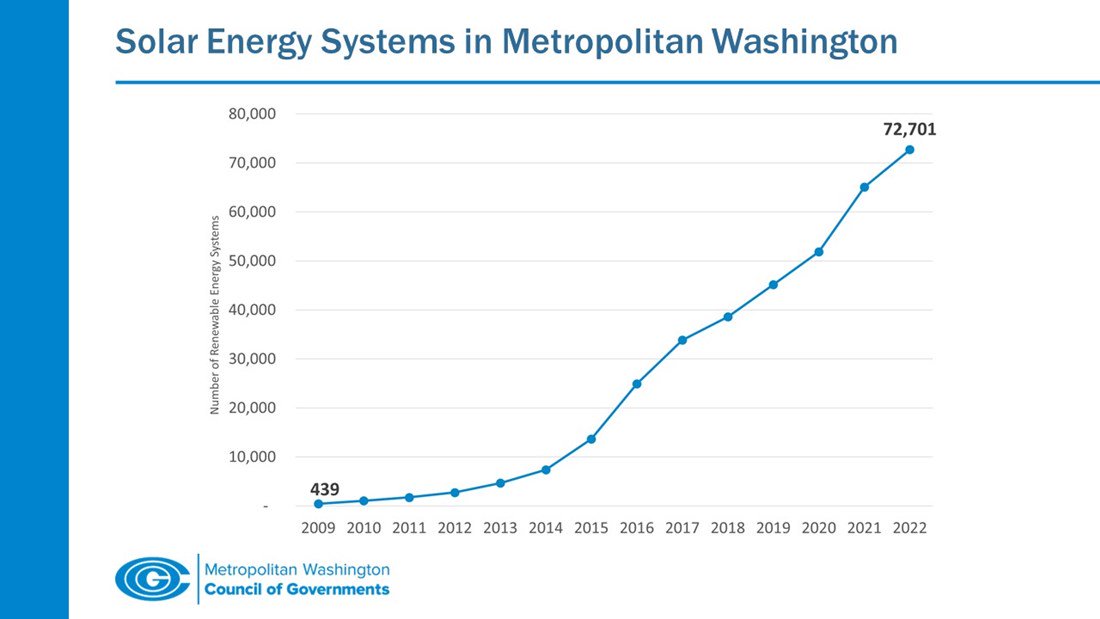Officials on the Metropolitan Washington Council of Governments (COG) Board of Directors adopted a set of new regional solar energy goals today, as leaders in metropolitan Washington work to meet the region’s broader climate goals for 2030.
Briefed on recommendations from the COG Climate, Energy, and Environment Policy Committee (CEEPC), the COG Board endorsed a goal of 250,000 solar rooftops in the region by 2030, with additional goals that call on local jurisdictions to pursue solar installations on government facilities, explore renewable energy for 100 percent of government operations, and support community-wide efforts to deploy solar, including programs for low-income residents, efficient zoning and permitting processes, and incentives. Currently, there are approximately 73,000 solar energy installations in the region.
“The goals adopted by the COG Board today reflect our region’s unified front to accelerate action on reducing carbon emissions to create a cleaner, sustainable future for all,” said Kate Stewart, COG Board Chair and Montgomery County Councilmember, noting that “With an emphasis on equity, these goals help target investments in clean energy infrastructure toward creating a robust and accessible network throughout metropolitan Washington.”

The Metropolitan Washington 2030 Climate and Energy Action Plan, adopted by the COG Board in 2020 and included in its Region United planning framework, established widespread adoption of solar energy as a priority action for area governments and partners to meet the region’s climate and energy goals, which include a 50 percent reduction in greenhouse gas (GHG) emissions below 2005 levels by 2030.
“As a region, we’ve seen promising momentum in efforts to increase the number of solar energy systems since adopting our climate goals in 2020, but hurdles remain as we look to achieve widespread adoption of renewables.” said Takis Karantonis, Chair of CEEPC and Arlington County Board Member, who presented to the COG Board on behalf of CEEPC at today’s briefing. “These goals set a target number for solar energy systems, but also provide a playbook for our region’s localities as leaders work to facilitate these infrastructure investments in an equitable and efficient manner, while maximizing multilayered benefits for our climate, our people and our economy,” he added.
The action taken today follows a previous briefing to the COG Board on solar and renewable energy initiatives in the region. The discussion highlighted successful programs as well as current and anticipated challenges and opportunities in deploying solar energy systems throughout communities.
Specifically, the COG Board voted to:
- Endorse a goal of 250,000 solar rooftops deployed in the region by 2030
- Urge all COG members to install solar on government facilities, including public schools, government buildings, and carports;
- Urge all COG members to explore procuring 100 percent of electricity for government operations with renewable energy;
- Encourage all members to support community-wide efforts to deploy solar through programs for low-income residents; effective industry engagement; efficient zoning and permitting; provision of incentives, rebates, and grants; support for bulk purchasing and solar co-ops and community choice aggregation; and work force development;
- Direct the COG Climate, Energy and Environment Policy Committee to support member governments in efforts to meet the solar energy goals and report back to the Board on progress of meeting the goals.
COG is supporting area jurisdictions’ efforts to implement Solar for All programs and to leverage other grant funding for infrastructure investments, including the advancement of renewable energy sources, as opportunities are made available. COG’s IIJA and IRA databases compile information on various federal grant programs to aid localities in pursuing additional funding, and the COG Electric Vehicle (EV) Deployment Clearinghouse offers a comprehensive list of federal and state grants to support clean energy and EV charging infrastructure.
COG plans to convene local government procurement and facilities offices—as well as private sector partners —in the new year to help advance these goals.